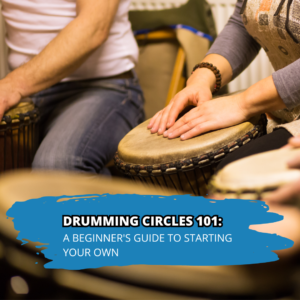Drumming Circles 101: A Beginner’s Guide to Starting Your Own

Drumming circles have emerged as a vibrant cornerstone in the tapestry of communal music-making, inviting individuals from all walks of life to partake in the rhythmic journey.
The Essence of Drumming Circles
Drumming circles are communal gatherings where participants express themselves through rhythm and percussion. At the heart of drumming circles is the collective effort to create harmony and unity through music. These gatherings are not just about playing drums; they’re a form of communication and community building. Participants in drumming circles come together to share in the joy of music, regardless of their musical background or abilities.
This inclusivity is what makes drumming circles a powerful tool for connection and healing. Through the rhythmic beating of drums, individuals find a common ground, transcending language and cultural barriers. Drumming circles foster a sense of belonging and collective joy, making them a cherished activity among diverse groups. They offer a unique opportunity for individuals to explore the world of music in a supportive and engaging environment.
Benefits of Participating in Drumming Circles
Participating in drumming circles offers numerous benefits, both psychological and social. Firstly, drumming circles are known to reduce stress and anxiety, as the act of drumming provides a therapeutic outlet for emotions. The rhythmic patterns and physical activity involved can lead to a meditative state, promoting mental clarity and relaxation. Socially, drumming circles provide a platform for individuals to connect with others, fostering a sense of community and belonging.
They encourage teamwork and cooperation, as participants work together to create a cohesive musical piece. Drumming circles also enhance musical skills and rhythm awareness, making them an excellent learning opportunity for beginners. The environment is supportive, allowing individuals to experiment and learn without fear of judgment. Additionally, drumming circles are accessible to people of all ages and abilities, making them a universally inclusive activity. They celebrate diversity and encourage cultural exchange, enriching participants’ experiences and understanding.
Essential Equipment for Drumming Circles
The foundation of any drumming circle is its array of instruments, each contributing its unique voice to the collective melody.
Types of Drums and Percussion Instruments
In drumming circles, a variety of drums and percussion instruments are used to create a rich tapestry of sounds. Djembes, a West African drum, are popular for their versatility and dynamic range. Congas, originating from Cuba, offer deep, resonant tones that complement the djembe’s sound. Frame drums, including tambourines, provide a higher pitch and are easy for beginners to handle.
Bongos, small hand drums, add a lively rhythm to the mix. Additionally, shakers, rainsticks, and woodblocks are essential for adding texture and complexity to the music. Each instrument contributes its unique sound, allowing for endless musical exploration. Participants do not need to own or be proficient in playing these instruments; drumming circles are about exploration and collaboration, making them perfect for novices.
Other Necessary Equipment
Besides drums and percussion instruments, a few other items are essential for a successful drumming circle. Comfortable seating, such as chairs or cushions, ensures participants can play for extended periods without discomfort. A central space, free from obstructions, allows the circle to form naturally and facilitates visual and auditory connection among participants.
Good lighting, whether natural or artificial, enhances the ambiance and ensures safety. A sound system might be needed for larger groups or outdoor settings to balance the sound throughout the circle. Also, water and refreshments keep everyone hydrated and comfortable. Providing these elements creates a welcoming and functional space for the drumming circle to thrive.
Facilitating a Drumming Circle
The facilitator stands at the forefront steering the group through waves of rhythm and harmony, ensuring every voice is heard and every beat finds its place.
Setting Up the Environment
Creating the right environment is crucial for the success of drumming circles. The space should be arranged in a circle to promote equality and visibility among participants. This layout fosters a sense of unity and connectedness, essential for collaborative music-making. The location should be chosen with acoustics in mind; a space that naturally amplifies sound can enhance the experience.
Outdoor settings offer a unique ambiance but require consideration for weather and noise levels. Indoor spaces should be spacious enough to accommodate the group comfortably. The facilitator should ensure the area is free of distractions and conducive to focus and relaxation. By carefully selecting and arranging the space, the facilitator sets the stage for a successful drumming circle.
Leading the Session
Leading a drumming circle requires a blend of musical knowledge and interpersonal skills. The facilitator should start with simple rhythms to warm up the group and gradually introduce more complex patterns. It’s important to encourage experimentation and individual expression while maintaining the overall harmony of the circle.
The leader must be attentive to the group’s energy and dynamics, ready to adjust the pace or direction of the session as needed. Effective communication, both verbal and non-verbal, helps guide participants and keep the session flowing smoothly. The facilitator should also be prepared to teach basic drumming techniques and rhythms to newcomers, ensuring everyone can participate fully. By providing clear direction and support, the facilitator helps create an inclusive and enjoyable experience for all.
Creating an Inclusive and Welcoming Environment
At the heart of drumming circles is the principle of inclusivity, a welcoming embrace that gathers individuals from diverse backgrounds into a unified ensemble.
Encouraging Participation
Encouraging participation is key to creating an inclusive drumming circle. The facilitator should actively invite individuals to join, emphasizing that no prior musical experience is required. Offering a variety of instruments allows participants to choose what feels most comfortable to them, fostering a sense of personal connection to the music. Demonstrating basic rhythms and techniques can help newcomers feel more confident.
It’s important to celebrate each participant’s contributions, regardless of skill level, to build a supportive atmosphere. Encouraging smiles, eye contact, and positive feedback within the group strengthens the sense of community. By creating a space where everyone feels valued and able to contribute, drumming circles become a powerful tool for inclusion and personal growth.
Addressing Common Concerns
Addressing common concerns upfront can alleviate anxieties and make drumming circles more accessible. Many newcomers worry about not having rhythm or being unable to keep up. The facilitator can reassure participants that drumming circles are about collective enjoyment, not individual performance. Emphasizing the value of experimentation and the non-judgmental nature of the group can encourage hesitant individuals to participate.
It’s also important to discuss practical matters, such as what to bring and what to expect during the session. Providing clear information on the structure and goals of the drumming circle can help set participants at ease. By addressing these concerns, facilitators can create a welcoming environment that encourages people from all walks of life to join and enjoy the benefits of drumming together.
Uniting Rhythms at Elite Music Academy
We understand the profound impact that music can have on individuals and communities alike. Our commitment to nurturing musical talents and fostering a sense of community is embodied in our comprehensive drum lessons, designed to resonate with the spirit of drumming circles. We believe in the power of rhythm to connect people, transcending barriers and creating a harmonious environment for all.
Through our tailored drumming lessons, students embark on a rhythmic journey that not only hones their technical skills but also immerses them in the collaborative essence of music-making. As we reflect on the principles highlighted in our guide to starting your own drumming circle, we stand as a beacon for aspiring drummers, offering a space where passion for music ignites, skills are refined, and the timeless tradition of communal drumming continues to thrive. Join us, and be part of a musical adventure that celebrates the uniting force of rhythm!
FAQs
1. What is the best time of day to host a drumming circle?
The best time depends on the group’s preference and the location’s availability. Outdoor drumming circles can be magical at sunset, while indoor sessions may be scheduled for evenings or weekends when participants are more likely to be free.
2. Do I need to be musically talented to participate in a drumming circle?
No, drumming circles welcome individuals of all skill levels, including beginners. They are designed to be inclusive and accessible, focusing on the joy of participation rather than musical expertise.
3. Can children participate in drumming circles?
Yes, drumming circles are a fantastic activity for children, as they encourage musical exploration, cooperation, and social interaction. However, it’s important to ensure the environment is safe and suitable for their participation.
4. How many people are needed to form a drumming circle?
Drumming circles can vary in size, but even a small group of 3-4 people can create a meaningful experience. Larger circles offer a richer sound and more varied interaction.
5. What should I wear to a drumming circle?
Comfortable, casual clothing that doesn’t restrict movement is ideal, as drumming can be physically active. Consider the location and weather if the event is outdoors.






